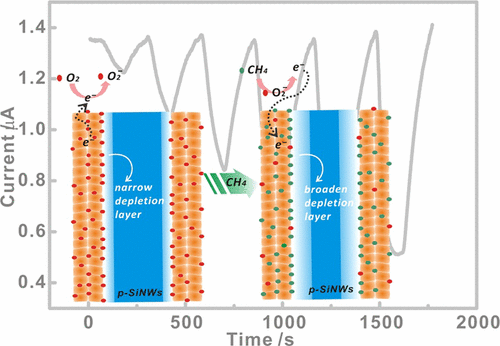Our official English website, www.x-mol.net, welcomes your feedback! (Note: you will need to create a separate account there.)
Low Power Consumption Gas Sensor Created from Silicon Nanowires/TiO2 Core–Shell Heterojunctions
ACS Sensors ( IF 8.9 ) Pub Date : 2017-09-22 00:00:00 , DOI: 10.1021/acssensors.7b00459 Dong Liu 1 , Leimiao Lin 1 , Qiaofen Chen 1 , Hongzhi Zhou 1 , Jianmin Wu 1
ACS Sensors ( IF 8.9 ) Pub Date : 2017-09-22 00:00:00 , DOI: 10.1021/acssensors.7b00459 Dong Liu 1 , Leimiao Lin 1 , Qiaofen Chen 1 , Hongzhi Zhou 1 , Jianmin Wu 1
Affiliation

|
Silicon nanowires/TiO2 (SiNWs/TiO2) array with core–shell nanostructure was created by sol–gel and drop-casting methods. The hybrid material displayed excellent sensing performance for CH4 detection at room temperature. The chemiresistor sensor has a linear response toward CH4 gas in the 30–120 ppm range with a detection limit of 20 ppm, which is well below most CH4 sensors reported before. The enhanced gas sensing performance at room temperature was attributed to the creation of heterojunctions that form a depletion layer at the interface of SiNWs and TiO2 layer. Adsorption of oxygen and corresponding gas analyte on TiO2 layer could induce the change of depletion layer thickness and consequently the width of the SiNWs conductive channel, leading to a sensitive conductive response toward gas analyte. Compared to conventional metal oxide gas sensors, the room temperature gas sensors constructed from SiNWs/TiO2 do not need an additional heating device and work at power at the μW level. The low power consumption feature is of great importance for sensing devices, if they are widely deployed and connected to the Internet of Things. The innovation of room temperature sensing materials may push forward the integration of gas sensing element with wireless device.
中文翻译:

由硅纳米线/ TiO 2核-壳异质结构成的低功耗气体传感器
通过溶胶-凝胶法和滴铸法创建了具有核-壳纳米结构的硅纳米线/ TiO 2(SiNWs / TiO 2)阵列。这种杂化材料在室温下对CH 4的检测显示出出色的感测性能。化学传感器传感器对CH 4气体的线性响应在30–120 ppm范围内,检出限为20 ppm,远低于以前报道的大多数CH 4传感器。室温下增强的气体感测性能归因于异质结的形成,该异质结在SiNWs和TiO 2层的界面处形成了耗尽层。氧气和相应的气体分析物在TiO 2上的吸附氮化硅层可能会引起耗尽层厚度的变化,进而引起SiNWs导电通道的宽度变化,从而导致对气体分析物的灵敏导电响应。与传统的金属氧化物气体传感器相比,由SiNWs / TiO 2构成的室温气体传感器不需要额外的加热装置,并且可以以μW的功率工作。如果传感设备被广泛部署并连接到物联网,那么低功耗功能对于传感设备就非常重要。室温感测材料的创新可能会推动气体感测元件与无线设备的集成。
更新日期:2017-09-22
中文翻译:

由硅纳米线/ TiO 2核-壳异质结构成的低功耗气体传感器
通过溶胶-凝胶法和滴铸法创建了具有核-壳纳米结构的硅纳米线/ TiO 2(SiNWs / TiO 2)阵列。这种杂化材料在室温下对CH 4的检测显示出出色的感测性能。化学传感器传感器对CH 4气体的线性响应在30–120 ppm范围内,检出限为20 ppm,远低于以前报道的大多数CH 4传感器。室温下增强的气体感测性能归因于异质结的形成,该异质结在SiNWs和TiO 2层的界面处形成了耗尽层。氧气和相应的气体分析物在TiO 2上的吸附氮化硅层可能会引起耗尽层厚度的变化,进而引起SiNWs导电通道的宽度变化,从而导致对气体分析物的灵敏导电响应。与传统的金属氧化物气体传感器相比,由SiNWs / TiO 2构成的室温气体传感器不需要额外的加热装置,并且可以以μW的功率工作。如果传感设备被广泛部署并连接到物联网,那么低功耗功能对于传感设备就非常重要。室温感测材料的创新可能会推动气体感测元件与无线设备的集成。



























 京公网安备 11010802027423号
京公网安备 11010802027423号